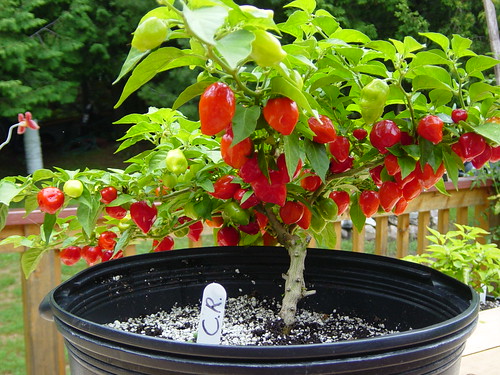All of my Caribbean Red's form all sorts of pod shapes, all on the same plant. You name it (exceptions being heavily wrinkled, long and skinny):
smooth and tapered,
dented or dimpled,
wrinkled at top,
smooth at top,
round,
oval,
flat.
All of these different shapes on the
same plant. You cannot take the pod shape as the only identifier as the Caribbean Red has a very unstable pod shape that changes throughout the season.
Many claim to be growing Red Savinas and actually have Caribbean Reds or something else, the reason for this isn't well known but here is the short story. All of this information can be found throughout the internet.
Real Red Savinas were
a mutant of an
Orange Habanero found growing in a
commercial Orange Habanero field (
Reference). From what I have seen and heard, the plant looks
identical to an Orange Habanero plant with the exception of the pods being
red when ripe, more
dented and wrinkled and
abnormally hot (duh). Orange Habaneros have longer ovate leaves with
dark green immature pods (thus so do Red Savinas) like this...
while Caribbean Reds have shorter heart shaped or roundish leaves with
light green immature pods that are mostly smooth (no bumps and very few if any dents) and are not heavily wrinkled, also they may have some minor wrinkling at the top near the stem and the pod shapes can vary allot on the same plant either at the same time or different times of the year. They also have
very short stems, which tends to leave some pods
erect to
horizontal instead of pendant.
Just because you purchased seeds online or from a buddy that claims to be "Red Savina" doesn't mean you are growing real Red Savinas, which are protected and ILLEGAL to sell or commercially grow without a proper license. That is why it is so damn hard to find REAL Red Savina seeds, also dried Red Savinas have inviable seeds due to the drying process they use. Since there exists a Red Habanero that is around the same shape and size that is also much hotter than a normal Orange Habanero (the Caribbean Red), people have knowingly and unknowingly sold Caribbean Red seeds as "Red Savina" seeds because most people won't know the difference. In fact, RedSavina.com sells Caribbean Red seeds that they label as "Red Habanero" (since they cannot sell real seeds due to the plant protection) which is confusing to most people that don't know this.
If the Red Savina and Caribbean Red habanero were really
so close that their differences were "infinitesimal" then they are NOT different and are one in the same! And since Caribbean Red habaneros were developed by Seminis Vegetable (
Reference) for commercial use in Antigua and Barbados (
don't believe me, look it up) if they were the same plant, than the guy who claimed he developed the Red Savina is actually growing a variety produced years before the Red Savina was even a twinkle in his eye.
The bottom line is, the Caribbean Red is a very unique plant, it has a great set of traits that make it a very good variety. You would be VERY hard pressed to find another different variety that had the same traits as a Caribbean Red.
Heart Shaped to Roundish Leaves - Not so common, long ovate more common
Light Green Immature pods - Recessive trait, tends to be lost in crosses with medium to dark green Immature pods
Short Compact Growth with Short Flower stems - Less common that long stem and leggy growth
Short to Medium length round pods with thick walls - A somewhat unique shape and tends to be much thicker than other C. Chinenses
Above Average Heat - Hotter than most Habaneros
Unique Flavor and Aroma - I only know of ONE other C. Chinense that has this aroma and flavor, that is the Chocolate Congo. From crosses I have done with other types, the flavor tends to be recessive and is drowned out or replaced by other C. Chinense flavors (known exception being the Orange Habanero).
Very prolific (high yeilds) - This plant pods up very well, I have had plants every year with > 100 pods at one point.
I have not seen a single plant in person or on the internet that did or was said to have all these qualities on the same plant. I challenge anyone to name another variety that does.

















